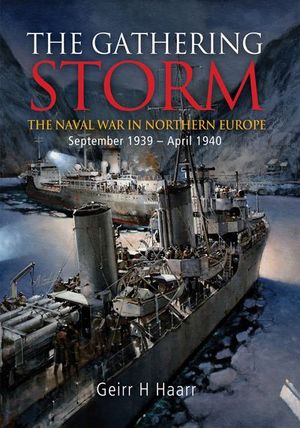The Gathering Storm
Published by Pen & Sword Books
“A top-of-the-line examination of operations in north European waters during the first eight months of [WWII] . . . by far the best work on that subject.”—Stone & Stone
The term “the phony war” is often applied to the first months of the Second World War, a term suggesting inaction or passivity. That may have been the perception of the war on land, but at sea it was very different. This new book is a superb survey of the fierce naval struggles, from 1939 up to the invasion of Norway in April 1940.
The author begins the book with the sinking of the German fleet at Scapa Flow in 1919 and then covers the rebuilding of the Kriegsmarine and parallel developments in the Royal Navy and summarizes relevant advances in European navies. The main part of the book then describes the actions at sea starting with the fall of Poland. There is a complex, intertwined narrative that follows. The sinking of Courageous, the German mining of the British East Coast, the Northern Patrol, the sinking of Rawalpindi, small ship operations in the North Sea and German Bight, the Altmark incident are all covered. Further afield the author deals with the German surface raiders and looks at the early stages of the submarine war in the Atlantic.
As with his previous books, Geirr Haarr has researched extensively in German, British, and other archives, and the work is intended to paint a balanced and detailed picture of this significant period of the war when the opposing naval forces were adapting to a form of naval warfare quite different to that experienced in WWI.
The term “the phony war” is often applied to the first months of the Second World War, a term suggesting inaction or passivity. That may have been the perception of the war on land, but at sea it was very different. This new book is a superb survey of the fierce naval struggles, from 1939 up to the invasion of Norway in April 1940.
The author begins the book with the sinking of the German fleet at Scapa Flow in 1919 and then covers the rebuilding of the Kriegsmarine and parallel developments in the Royal Navy and summarizes relevant advances in European navies. The main part of the book then describes the actions at sea starting with the fall of Poland. There is a complex, intertwined narrative that follows. The sinking of Courageous, the German mining of the British East Coast, the Northern Patrol, the sinking of Rawalpindi, small ship operations in the North Sea and German Bight, the Altmark incident are all covered. Further afield the author deals with the German surface raiders and looks at the early stages of the submarine war in the Atlantic.
As with his previous books, Geirr Haarr has researched extensively in German, British, and other archives, and the work is intended to paint a balanced and detailed picture of this significant period of the war when the opposing naval forces were adapting to a form of naval warfare quite different to that experienced in WWI.
BUY NOW FROM
COMMUNITY REVIEWS

